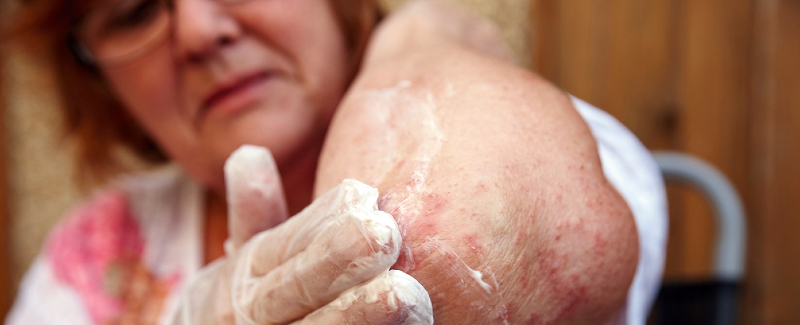Pavilion Publishing and Media Ltd
Blue Sky Offices Shoreham, 25 Cecil Pashley Way, Shoreham-by-Sea, West Sussex, BN43 5FF, UNITED KINGDOM
Managing common skin conditions in older people
Eczema, psoriasis, and pruritus are common skincare issues for older people. Kathy Oxtoby looks at the advice, support and treatments practitioners can offer patients with what can be distressing conditions.
Dermatology conditions are extremely common, affecting anyone of any age. But with age comes changes to the skin that can make it more prone to disease. It becomes less oily, less elastic, thinner, bruises easily, and can take a long time to heal when cut.1
Skin disease can affect older patients’ physical health, causing pain, sleep disturbance and itching. But it can also affect their mental wellbeing, resulting in loss of confidence, depression, anxiety, and problems with interpersonal relationships, as well as impacting on other family members and carers.2
Common skin diagnoses in older people are eczema, psoriasis and pruritus. Here we look at their symptoms, triggers and treatments, and how practitioners can support patients with these often distressing conditions.
[rml_read_more]
Eczema: “replace and protect the skin barrier”
Eczema is often thought of as a childhood condition, “but that’s not accurate”, says the National Eczema Society. “Eczema may improve after childhood, but it can return later on at any stage of life. Eczema can also suddenly appear for the first time in later life,” the UK charity says.
- Further reading: Dermatology special issue
Skin becomes drier with age, which can lead to roughness, scaling and itchiness. In women at menopause, as oestrogen levels decline, changes in the skin are observed that make the skin more prone to eczema.3
Certain types of eczema are more common in later years. Older people are most likely to develop varicose (gravitational/venous) eczema if they have reduced mobility, high blood pressure or varicose veins, or have had deep vein thrombosis, phlebitis or cellulitis in the past. With varicose eczema, the skin becomes very thin and fragile on the lower legs and can easily break down, leading to an ulcer. When severe, varicose eczema can have weeping, crusted areas.3
Asteatotic eczema is also more common in older people. It usually affects the shins but sometimes affects other areas such as the thighs, arms, stomach and back. With this kind of eczema, the skin becomes very dry, rough and scaly, and can sometimes present as a crazy paving like pattern on the legs.3
Triggers for eczema include central heating, which can dry out the skin. It can also be a reaction to skincare products such as shampoo or soaps. “All these issues can become worse in older age because the skin, being drier, allows these ingredients to be absorbed and trigger irritation,” says Sara Burr, a community dermatology specialist nurse for Norfolk Community Health and Care NHS Trust.
Air borne allergens from cats, dogs, pollen, grass or the house dust-mite, can also cause flare-ups of atopic eczema for some patients.4
To keep eczema at bay, patients are also advised to “turn down the heating, apply emollient more often, use cotton gloves when touching potential irritants, and drink more fluids”, says Ms Burr.
If eczema is widespread and severe, patients will need to be referred to a consultant dermatologist, to assess their suitability for stronger treatments such as phototherapy or systemic immunosuppressants. If their eczema could be attributed to stress, they might benefit from seeking out additional sources of emotional support, such as counselling.3
Practitioners can advise older patients with eczema to adapt their environment, including keeping their bedrooms cool, and putting in place measures to reduce the risk of slipping, such as bath mats on tiled bathroom floors, because emollients can be slippery on certain surfaces, advises Julie Van Onselen, a dermatology lecturer practitioner in Oxford.
Psoriasis: “difficulties with daily living activities”
Psoriasis is a chronic dry scaly inflammatory skin condition, which results in scaly, sometimes sore or itchy plaques. “There are genetic factors that may predict the likelihood of developing psoriasis. There are likely to be environmental factors, but these are not well understood,” says Dr Keith.
Around 1.2 million people in the UK are living with psoriasis, and with the ageing of the population it is becoming increasingly widespread among older people.5
Psoriasis, particularly moderate to severe psoriasis, is linked to an increased risk of anxiety, depression and harmful use of alcohol. Moderate to severe psoriasis increases the risk of heart disease and stroke, and treatment of psoriasis may reduce this risk. And the condition can also be associated with diabetes, obesity, venous thromboembolism, high cholesterol and high blood pressure.6
Dr Keith explains that psoriasis causes difficulties with activities of daily living, particularly when affecting hands and feet, and it may be accompanied by arthritis. And having patchy scaly skin in conditions like psoriasis can lead to social stigma, especially in older people.
Infections, stress, damage to the skin, alcohol, and sometimes intense sunlight may trigger flares of psoriasis. Certain medications such as beta blockers and lithium and some tablets used to treat malaria can also trigger a flare up. Suddenly stopping some steroid tablets can also trigger or worsen psoriasis.6
For older people with already dry skin and who may have other dry skin conditions like asteatotic eczema, “psoriasis can be particularly stubborn to treat on top of this”, says Dr Keith.
Psoriasis can usually be treated topically with, for example coal tar preparations, dithranol, emollients and soap substitutes, vitamin D analogues, corticosteroids and calcineurin inhibitors. Light treatment with UVB or PUVA can be used for more widespread disease, advises Dr Keith. Using regular emollients and soap substitutes may help reduce bad flare ups, he says.
When caring for someone with the condition, Dr Keith advises: “Try to think about someone’s psoriasis as being inflammatory and unstable or chronic and stable.” He says where there is a lot of inflammation – redness, soreness, itching, instability and rapid progression – to use anti-inflammatory treatments first, like steroids.
When the skin enters “a stable chronic phase – more complaints of scale, less of itch or soreness – then switch to anti proliferative treatment like tar and vitamin D analogues”, he says.
Obesity and smoking are associated with a poor response to psoriasis treatments.6 Ms Van Onselen says practitioners can give their patients healthy lifestyle advice, including eating a balanced diet, and stopping smoking to help prevent flare ups.
Pruritus: “break the itch-scratch cycle”
Pruritus literally means itching. “There are many reasons older people may be itchy,” says Dr Keith.
Primary skin conditions such as eczema, psoriasis and lichen planus – a rash that can affect different parts of the body, including the inside of the mouth – may be the cause. Secondary causes of itching include drugs (opiate analgesia), drug reactions, chronic disease affecting internal organs like the liver and kidneys, and internal malignancy, explains Dr Keith.
The triggers of pruritus are often those similar to eczema, such as the natural drying out of the skin with age, he says.
Chronic pruritus is compounded by problems faced by many older people. This includes insomnia (as this increases time available for scratching), boredom and loneliness, bereavement, financial difficulties, chronic health issues and polypharmacy.2
Intense itching can “significantly affect people’s mental health through disturbed sleep, a feeling of being unclean in some way, a fear of parasites, a fear of an internal cause for the itching and social stigmatisation”, says Dr Keith.
When treating pruritus, “the main aim is to break the itch-scratch cycle”, says Dr Keith. Topical corticosteroids and calcineurin inhibitors can be used to suppress any inflammation. Emollients and soap substitutes can help maintain the skin barrier function and reduce the risk of secondary infection. Sedative antihistamines can help at night, but are often contraindicated in the older patient. Zinc paste bandages at night can be soothing and prevent contact with the damaged skin. There are also creams containing menthol or capsaicin that can provide distraction to compete with itch signals, says Dr Keith.
As with eczema and psoriasis, good skin care with emollients and soap substitutes can prevent relapse, he says.
Failure to investigate pruritus means that underlying conditions can be missed, such as cancer – itchy skin can be a symptom – as well as complications resulting from the physical deterioration of the skin, says Ms Van Onselen.
To help manage pruritis, patients are advised to avoid situations where they tend to scratch by changing their habits, to try patting the skin instead of scratching, and to avoid soaking in baths for long periods as hot water may remove the natural oils from the skin. Laying a cool flannel soaked in moisturising cream on the skin can reduce the feeling of itch.7
While these common skin conditions may not be life threatening, practitioners should not dismiss the impact they can have on people’s lives over the years, says Ms Van Onselen. She advises: “Listen to the patient’s story, check the practicalities of how they apply their treatments, and give them practical support.”
References
- Health in Aging (2020) Skin Diseases Are Common in Older Adults. Journal of the American Geriatrics Society Research Summary. https://www.healthinaging.org/blog/skin-diseases-are-common-in-older-adults/ [Accessed 31 March 2022]
- Singh S (2017) Common skin problems in the elderly. Gm Journal. https://www.gmjournal.co.uk/common-skin-problems-in-the-elderly [Accessed 31 March 2022]
- National Eczema Society (2022) Eczema in later life. https://eczema.org/information-and-advice/types-of-eczema/eczema-in-later-life/ [Accessed 31 March 2022]
- British Association of Dermatologists (BAD) (2020) Patient Information Leaflet. Eczema. https://www.bad.org.uk/shared/get-file.ashx?id=69&itemtype=document [Accessed 31 March 2022
- Gillard SE, Finlay AY. Current management of psoriasis in the United Kingdom: patterns of prescribing and resource use in primary care. Int J Clin Pract 2005; 59: 1260-67
- British Association of Dermatologists (BAD) (2018) Patient Information Leaflet. Psoriasis. https://www.bad.org.uk/shared/get-file.ashx?id=178&itemtype=document [Accessed 31 March 2022]
- British Association of Dermatologists (BAD) (2018) Patient Information Leaflet. Pruritus. https://www.bad.org.uk/shared/get-file.ashx?id=121&itemtype=document [Accessed 31 March 2022]



